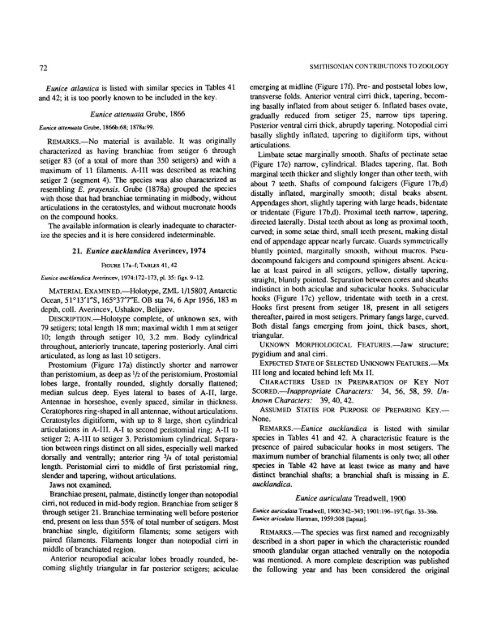A Review of the Genus Eunice - Smithsonian Institution Libraries
A Review of the Genus Eunice - Smithsonian Institution Libraries
A Review of the Genus Eunice - Smithsonian Institution Libraries
Create successful ePaper yourself
Turn your PDF publications into a flip-book with our unique Google optimized e-Paper software.
72 SMITHSONIAN CONTRIBUTIONS TO ZOOLOGY<br />
<strong>Eunice</strong> atlantica is listed with similar species in Tables 41<br />
and 42; it is too poorly known to be included in <strong>the</strong> key.<br />
<strong>Eunice</strong> attenuata Grube, 1866<br />
<strong>Eunice</strong> attenuata Grube, 1866b:68; 1878a:99.<br />
REMARKS.—No material is available. It was originally<br />
characterized as having branchiae from setiger 6 through<br />
setiger 83 (<strong>of</strong> a total <strong>of</strong> more than 350 setigers) and with a<br />
maximum <strong>of</strong> 11 filaments. A-III was described as reaching<br />
setiger 2 (segment 4). The species was also characterized as<br />
resembling E. prayensis. Grube (1878a) grouped <strong>the</strong> species<br />
with those that had branchiae terminating in midbody, without<br />
articulations in <strong>the</strong> ceratostyles, and without mucronate hoods<br />
on <strong>the</strong> compound hooks.<br />
The available information is clearly inadequate to characterize<br />
<strong>the</strong> species and it is here considered indeterminable.<br />
21. <strong>Eunice</strong> aucklandica Averincev, 1974<br />
FIGURE 17a-f; TABLES 41,42<br />
<strong>Eunice</strong> aucklandica Averincev. 1974:172-173, pi. 35: figs. 9-12.<br />
MATERIAL EXAMINED.—Holotype, ZML 1/15807, Antarctic<br />
Ocean, 51°13'1"S, 165°37'7"E. OB sta 74, 6 Apr 1956, 183 m<br />
depth, coll. Averincev, Ushakov, Belijaev.<br />
DESCRIPTION.—Holotype complete, <strong>of</strong> unknown sex, with<br />
79 setigers; total length 18 mm; maximal width 1 mm at setiger<br />
10; length through setiger 10, 3.2 mm. Body cylindrical<br />
throughout, anteriorly truncate, tapering posteriorly. Anal cirri<br />
articulated, as long as last 10 setigers.<br />
Prostomium (Figure 17a) distinctly shorter and narrower<br />
than peristomium, as deep as l li <strong>of</strong> <strong>the</strong> peristomium. Prostomial<br />
lobes large, frontally rounded, slightly dorsally flattened;<br />
median sulcus deep. Eyes lateral to bases <strong>of</strong> A-II, large.<br />
Antennae in horseshoe, evenly spaced, similar in thickness.<br />
Ceratophores ring-shaped in all antennae, without articulations.<br />
Ceratostyles digitiform, with up to 8 large, short cylindrical<br />
articulations in A-III. A-I to second peristomial ring; A-II to<br />
setiger 2; A-III to setiger 3. Peristomium cylindrical. Separation<br />
between rings distinct on all sides, especially well marked<br />
dorsally and ventrally; anterior ring 3 /4 <strong>of</strong> total peristomial<br />
length. Peristomial cirri to middle <strong>of</strong> first peristomial ring,<br />
slender and tapering, without articulations.<br />
Jaws not examined.<br />
Branchiae present, palmate, distinctly longer than notopodial<br />
cirri, not reduced in mid-body region. Branchiae from setiger 8<br />
through setiger 21. Branchiae terminating well before posterior<br />
end, present on less than 55% <strong>of</strong> total number <strong>of</strong> setigers. Most<br />
branchiae single, digitiform filaments; some setigers with<br />
paired filaments. Filaments longer than notopodial cirri in<br />
middle <strong>of</strong> branchiated region.<br />
Anterior neuropodial acicular lobes broadly rounded, becoming<br />
slightly triangular in far posterior setigers; aciculae<br />
emerging at midline (Figure 17f). Pre- and postsetal lobes low,<br />
transverse folds. Anterior ventral cirri thick, tapering, becoming<br />
basally inflated from about setiger 6. Inflated bases ovate,<br />
gradually reduced from setiger 25, narrow lips tapering.<br />
Posterior ventral cirri thick, abruptly tapering. Notopodial cirri<br />
basally slightly inflated, tapering to digitiform tips, without<br />
articulations.<br />
Limbate setae marginally smooth. Shafts <strong>of</strong> pectinate setae<br />
(Figure 17e) narrow, cylindrical. Blades tapering, flat. Both<br />
marginal teeth thicker and slightly longer than o<strong>the</strong>r teeth, with<br />
about 7 teeth. Shafts <strong>of</strong> compound falcigers (Figure 17b,d)<br />
distally inflated, marginally smooth; distal beaks absent.<br />
Appendages short, slightly tapering with large heads, bidentate<br />
or tridentate (Figure 17b,d). Proximal teeth narrow, tapering,<br />
directed laterally. Distal teeth about as long as proximal tooth,<br />
curved; in some setae third, small teeth present, making distal<br />
end <strong>of</strong> appendage appear nearly furcate. Guards symmetrically<br />
bluntly pointed, marginally smooth, without mucros. Pseudocompound<br />
falcigers and compound spinigcrs absent. Aciculae<br />
at least paired in all sctigcrs, yellow, distally tapering,<br />
straight, bluntly pointed. Separation between cores and sheaths<br />
indistinct in both aciculae and subacicular hooks. Subacicular<br />
hooks (Figure 17c) yellow, tridentate with teeth in a crest.<br />
Hooks first present from setiger 18, present in all setigers<br />
<strong>the</strong>reafter, paired in most setigers. Primary fangs large, curved.<br />
Both distal fangs emerging from joint, thick bases, short,<br />
triangular.<br />
UKNOWN MORPHOLOGICAL FEATURES.—Jaw structure;<br />
pygidium and anal cirri.<br />
EXPECTED STATE OF SELECTED UNKNOWN FEATURES.—Mx<br />
III long and located behind left Mx II.<br />
CHARACTERS USED IN PREPARATION OF KEY NOT<br />
SCORED.—Inappropriate Characters: 34, 56, 58, 59. Unknown<br />
Characters: 39, 40,42.<br />
ASSUMED STATES FOR PURPOSE OF PREPARING KEY.—<br />
None.<br />
REMARKS.—<strong>Eunice</strong> aucklandica is listed with similar<br />
species in Tables 41 and 42. A characteristic feature is <strong>the</strong><br />
presence <strong>of</strong> paired subacicular hooks in most setigers. The<br />
maximum number <strong>of</strong> branchial filaments is only two; all o<strong>the</strong>r<br />
species in Table 42 have at least twice as many and have<br />
distinct branchial shafts; a branchial shaft is missing in E.<br />
aucklandica.<br />
<strong>Eunice</strong> auriculata Treadwell, 1900<br />
<strong>Eunice</strong> auriculata Treadwell, 1900:342-343; 1901:196-197, figs. 33-36b.<br />
<strong>Eunice</strong> ariculata Hartman, 1959:308 [lapsus].<br />
REMARKS.—The species was first named and recognizably<br />
described in a short paper in which <strong>the</strong> characteristic rounded<br />
smooth glandular organ attached ventrally on <strong>the</strong> notopodia<br />
was mentioned. A more complete description was published<br />
<strong>the</strong> following year and has been considered <strong>the</strong> original
















